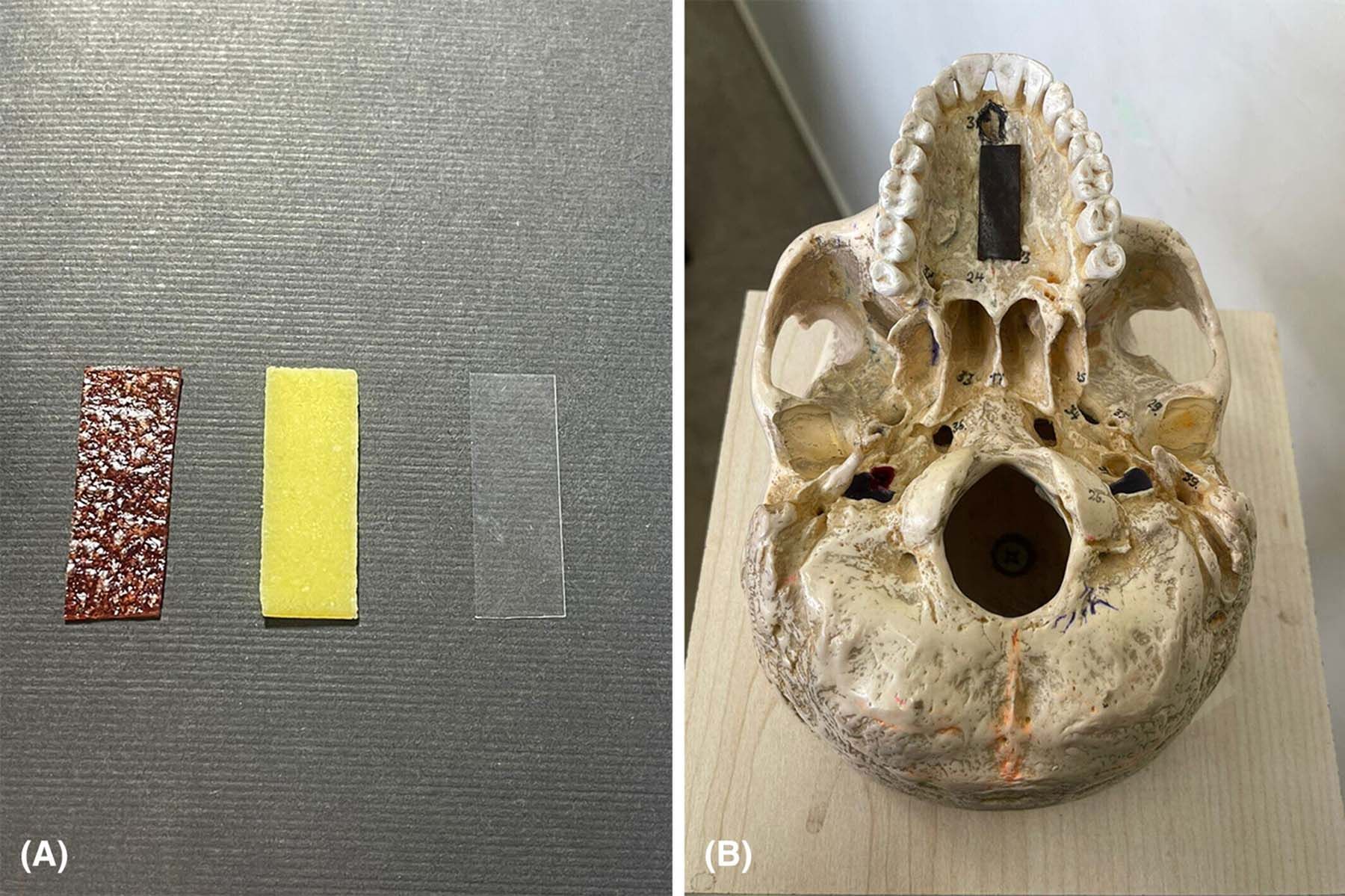Fruit Roll-Ups May Be Hard on Teeth, But Can Help with Dental X-ray Quality
New study indicates using the edible strips can deliver the highest frequency of excellent and diagnostically acceptable images, with less errors.
Figure 1A-B: From left to right an example of sour fruit leather (thickness: 1 mm), chewing gum (thickness: 1 mm) and celluloid matrix strip (thickness: 5 μm) (A). Approximate positioning of the strips (B). | Image Credit: © Journal of Medical Radiation Sciences

None of us are surprised to hear that chewy, sticky snacks like Fruit Roll-Ups are bad for your teeth. But a new study does show a surprising benefit from these sweet treats: using them can significantly reduce errors in panoramic radiography, helping to produce clearer images and better dental diagnostics.
A key obstacle to good panoramic radiography is the patient’s failure to keep the tongue against the palate, and the study, published in the Journal of Medical Radiation Sciences, indicates that the use of edible strips (fruit roll-ups) can ensure proper tongue positioning and thus reduce palatoglossal airspace (PGA) artifacts. These PGA artifacts can negatively affect radiographic images, and thus the dental diagnostics.
The article, titled, Effect of using different strips on reducing the most common error in panoramic imaging: A randomised controlled trial on palatoglossal air space shadow, was first published in February 2024.
You can read the full article here.
In the study, 270 patients were randomized into 3 groups: a control group, a celluloid matrix group and an edible tapes group (using fruit roll-ups, which the authors refer to as fruit leathers). Before panoramic imaging, the patients were instructed to adhere their tongues to the roof of their mouths, with the distinction that for the celluloid matrix and edible tapes groups, patients were asked to place celluloid tapes, fruit leathers, or chewing gums on their tongues before doing so, the study states. The routine imaging process was then performed, and the results were compared across groups to evaluate the incidence of palatoglossal airspace shadow errors.
This randomized controlled trial was conducted at the Oral and Maxillofacial Radiology Department, Faculty of Dentistry, Tabriz University of Medical Sciences, Iran, from September 29, 2021 to February 20, 2022.
The results indicated significant differences among the groups, with the control group producing the highest frequency of unacceptable images. The group using the edible strips delivered the highest frequency of excellent and diagnostically acceptable images, with the lowest occurrence of PGA errors. Using celluloid strips did prove to beeffective, but not as effective as using the roll-ups.
The published study breaks down some of the results in this fashion: “The number of error-free images in each fruit leather, chewing gum and celluloid tape group were significantly higher than the control group (all cases P < 0.05). The chances of error-free images in the fruit leather groups were the highest (9.57 times). The age (P = 0.136) and gender (P = 0.272) of patients had no significant effect on the results of interventions.”
The authors say the edible materials seem more favorable for the patients. Additionally, the fruit leather, due to its sour taste, had a higher effect on keeping the tongue against the palate. Also, the opacity of fruit leather and chewing gum compared to celluloid appears to positively influence radiograph quality regarding the incidence of PGA shadow error, the study reports.
Conclusion
The authors concluded that the study suggests that celluloid matrix and edible strips reduced PGA shadow error in panoramic imaging. Not only might this lead to more accurate diagnoses and better patient care, but any methods that reduce the need to repeat radiographs also will benefit patient health and safety in the long run.
A quick summary of the study’s highlights shows the “highest and lowest chance of error-free radiographs compared to the control group were recorded for fruit leather and celluloid strips, respectively. Thus, chewing gum, celluloid strip and especially fruit leather, a cheap and accessible foodstuff, can help minimize the error of not placing the tongue against the palate during panoramic imaging.”
More research is suggested to develop similar efficient strategies to achieve this goal, the authors state.
For now, however, it seems as if these popular fruit roll-ups might just improve their standing within the dental industry. Once known mainly for their caries-producing powers, they may just lead to a better, more efficient way for getting better dental x-rays.